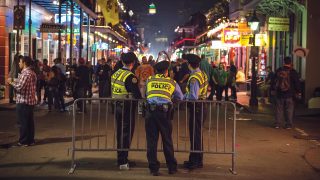
In recent years, the use of force by police officers is arguably getting more attention than any other issue in policing. Claims by civil rights leaders, politicians and media figures suggest that deaths from police use of force in the U.S. are widespread, epidemic and increasing, especially among African Americans. To verify this, it’s important to first determine the actual number of deaths each year, but this is challenging due to differing data sources. While the numbers of such deaths fluctuate from year to year, the average annual number of deaths from police use of force reported by the CDC (not police sources) over the last decade was under 500.
Jason Johnson, a former deputy commissioner of the Baltimore Police Department and president of the Law Enforcement Legal Defense Fund, notes that a 2020 AP-National Opinion Research Center (NORC) poll showed that 48% of the public viewed police violence as a serious issue, up from 32% in 2015. Despite this, police use of force is actually rare and has been decreasing. Over 99.9% of police calls are resolved peacefully, and 95% of officers never fire their weapons. The New York Police Department, the largest force in the U.S., has reduced shootings by 90% over the past few decades — from 810 incidents in 1971, resulting in 93 deaths, to 57 incidents in 2019, with 11 fatalities.
Over 99.9% of police calls are resolved peacefully, and 95% of officers never fire their weapons.
The U.S. Supreme Court case Graham v. Connor established the “objective reasonableness” standard for police use of force, meaning that whether force was appropriate is judged based on what a reasonable officer would do in the same situation, not the subjective beliefs of the officer involved. The basics of law enforcement’s legitimate use of force stem from the concept of reasonable seizure, based on the Fourth Amendment of the U.S. Constitution. According to John Bostain, the senior instructor for use-of-force training programs at the Federal Law Enforcement Training Centers (FLETC), when a police officer commands a suspect to stop, tackles them or shoots them, it counts as a seizure, as these actions restrict the suspect’s movement. While policies often encourage using the least force and least intrusive means for arrests, these are not legal requirements. They are ideal policy goals, but not the legal standard for use of force in the U.S. One question to consider in each individual case is: Was the officer’s use of force reasonable given the circumstances at the time of the seizure? In an article concerning common use-of-force myths, Duane Wolfe, who retired after a 25-year career as a Minnesota peace officer, observed that if minimal force was intended as the standard, the Supreme Court of the United States would have specified that. However, the SCOTUS has specifically stated that the proper use of force “is not capable of precise definition or mechanical application.”
In the 1994 case Scott v. Henrich, the Ninth Circuit stated that expecting officers to always choose the least intrusive option would require “superhuman judgment.” In high-stress situations where lives are at risk, officers are not required to select the least intrusive option, but rather a “reasonable” one. The law holds officers to this standard: force must be objectively reasonable based on the total circumstances at the time.
A Lexipol report, Use of Force Policies: Dispelling the Myths, compiled by a group of law enforcement and legal experts in 2020, noted that agencies are better off keeping their use-of-force policies aligned with the standards outlined in Graham v. Connor when determining the reasonable use of force — which would include the severity of the crime at issue, if the suspect poses an immediate threat to the safety of officers or others and whether the suspect is actively resisting arrest or attempting to flee. In Graham, the court acknowledges that officers must often make quick, life-or-death decisions that can’t always be precisely defined. The “objective reasonableness” standard allows for decisions based on the information available at the time.
The concept of “de-escalation” is often put forward as a simple, all-purpose solution that can be applied in most critical situations as an alternative to the use of force. The International Association of Chiefs of Police (IACP) uses the following definition of de-escalation from the National Consensus Policy: “Taking action or communicating verbally or non-verbally during a potential force encounter, in an attempt to stabilize the situation and reduce the immediacy of the threat, so that more time, options and resources can be called upon to resolve the situation without the use of force or with a reduction in the force necessary.” As explained by law enforcement trainer Bostain, working with the Michigan Association of Chiefs of Police, many people believe everyone can be “de-escalated” and that not doing so means the officer failed. However, there are three key truths about de-escalation that are often overlooked by those who haven’t dealt with violent individuals in crisis:
- De-escalation is a result, not a specific tactic. It can’t be measured just by whether force was used. Sometimes, reasonable force, like in an active shooter situation, is necessary to de-escalate.
- De-escalation can’t be imposed on an unwilling person in crisis. There’s no quick fix or “magic” solution to calm someone down in such situations.
- De-escalation cannot be guaranteed, as it ultimately depends on the individual’s choice. Officers can only use strategies to encourage the best outcome by promoting de-escalation. However, the reality is that some people will not de-escalate, no matter how much communication or how many options are offered.
In a 2012 Use of Force Symposium, the IACP determined that that police leadership should educate the public, but expressed concern that the lack of a national communication strategy hurt their ability to speak clearly on the issue. Without a unified, fact-based message, the media and other groups shape the narrative, often sensationalizing incidents or pushing specific agendas. As a result, police react to external stories rather than proactively sharing information. Nearly two-thirds of participants felt police were ineffective in communicating about use-of-force incidents. At the symposium, Philip Broadfoot, former chief of the Danville Police Department in Virginia, noted that “There is a large body of case law that permits the police to use force that is reasonably necessary to overcome the force used against them. The public often perceives that force as excessive when it is not.”
As a body, the IACP Symposium recommended that the law enforcement community develop a model communications strategy for law enforcement on the topic of use of force, along with a national media guide to inform the public regarding the dangers of policing and the necessity to use appropriate force in furtherance of public safety, as well as creating a sustainable online resource library detailing programs and summaries of approaches that have proven to build better relationships between police and their communities.
References
Bostain, John. “The Truth About De-Escalation.” virtualacademy.com/blog/the-truth-about-de-escalation.
Federal Law Enforcement Training Centers. “Use of Force: Myths and Realities.” fletc.gov/audio/use-force-myths-and-realities-part-i-mp3.
Johnson, Richard R. “Dispelling the Myths Surrounding Police Use of Lethal Force.” Dolan Consulting Group, July 2016. dolanconsultinggroup.com/wp-content/uploads/2019/02/Dispelling-the-Myths-Surrounding-Police-Use-of-Lethal-Force.pdf.
International Chiefs of Police/COPS Office Use of Force Symposium. “Emerging Use of Force Issues.” https://portal.cops.usdoj.gov/resourcecenter/content.ashx/cops-p232-pub.pdf.
Praet, Bruce, Mike Ranalli, Laura Scarry and Ken Wallantine. “Use of Force Policies: Dispelling the Myths.” Lexipol.
United Police Fund. “Promoting Myths About Police Won’t Make Us Safer.” unitedpolicefund.org/promoting-myths-about-police-wont-make-us-safer.
Wolfe, Duane. “5 common use-of-force myths debunked.” police1.com/officer-safety/articles/5-common-use-of-force-myths-debunked-ourIDpGptKCEAJR9.
As seen in the January 2025 issue of American Police Beat magazine.
Don’t miss out on another issue today! Click below:






